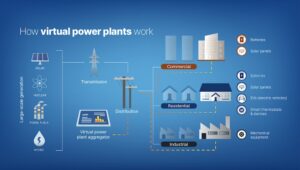5 June 2025
Unlock the Power of Your Home Battery: Understanding Virtual Power Plants (VPPs)
As more Australian homes embrace solar power, over 30% as of 2024, the way we manage and share energy is rapidly evolving. One of the most innovative solutions emerging is Virtual Power Plants (VPP). Imagine a network of interconnected home solar batteries working together, not just for individual households, but for the entire energy system. This collaboration allows homes to become more energy-independent while strengthening the reliability and efficiency of our power grid.
Firstly, what is a Virtual Power Plant (VPP)?
A Virtual Power Plant (VPP) isn’t a physical building. Instead, it’s a digital network that unites numerous smaller energy sources, primarily home solar batteries, across different locations. This virtual collective acts like a single, responsive power station, managing energy flow from countless distributed sources to provide a steady and reliable electricity supply.
Quick fact: While solar batteries are key, VPP’s can also integrate other distributed energy resources like small wind turbines or electric vehicle batteries, creating a dynamic energy system.
Key Features of a Virtual Power Plant:
- Decentralised Power: Energy is spread across many smaller, widespread locations, reducing reliance on single large power stations.
- Scalability: The more homes that join, the stronger and more effective the collective becomes.
- Smart Control: Advanced software continuously monitors energy production, consumption, prices, and grid demand to optimise energy flow.
So, How Do VPP’s Work?
VPPs cleverly connect solar batteries from many houses, forming a flexible network that supplies electricity when and where it’s needed most.
Step 1: Capturing and Storing Excess Energy
Your solar panels convert sunlight into electricity. Any surplus is stored in your home battery. This valuable energy can then be made available to the wider VPP network when demand arises.
Step 2: Intelligent Monitoring and Prediction
The VPP operator uses advanced software to continuously monitor each connected battery – its charge levels, solar generation, current electricity prices and grid demand – allowing the VPP to predict and respond efficiently.
Step 3: Sharing and Stabilising the Grid
When demand on the main electricity grid is high, the VPP can strategically discharge stored energy from participating batteries back into the grid. This reduces strain, helps prevent blackouts, and ensures consistent power. On the other hand, batteries can be charged during periods of low demand, further stabilising the grid.

Image sourced from Solar Reviews
What Are The Benefits of Joining A VPP?
VPP’s offer advantages for individual homeowners and contribute significantly to grid stability and sustainability.
- Potential Cost Savings and Earning For Homeowners:
You can earn income by allowing your battery to discharge energy to the grid during peak demand. Some VPP programs offer upfront battery discounts, ongoing payments or enhanced feed-in tariffs (a feed-in tariff (FiT) is a credit you can receive for any unused electricity sent back to the grid), making home energy storage more accessible.
- Enhanced grid Stability and Reliability:
VPP’s play a crucial role in maintaining a stable power supply by releasing stored energy during peak times or absorbing excess solar, reducing grid stress and blackout risks.
- Positive Environmental Impact:
By pooling and optimising renewable energy, VPPs reduce reliance on fossil fuel power plants, lowering carbon emissions and supporting Australia’s transition to cleaner energy.
- Increased Energy Independence:
While part of a larger network, you generally retain backup power. VPP’s can help you maximise your solar investment, giving you greater control and reducing reliance on expensive grid power during peak periods.
What Do You Need To Consider Before Joining A VPP?
While beneficial, it’s important to approach VPPs with a clear understanding:
- Understanding the Terms: Programs vary widely. Always read the fine print to understand compensation (upfront discounts, payments or feed-in tariffs).
- Battery Control: You allow a third party (like an energy retailer or operators like Tesla, AGL, etc.) to manage your batteries charging/discharging for grid benefit, meaning some loss of direct control.
- Battery Lifespan: Consider how a VPP’s demands might impact your battery’s lifespan.
- Eligibility: Not all batteries are compatible with every VPP program.
The Queensland energy landscape is continuously evolving, and VPP’s are set to become an increasingly important part of it. They offer a compelling way to make your solar battery work harder for you, benefiting both your wallet and the wider community. For a VPP comparison table as at July 2025 see here
Our Final Thoughts
Virtual Power Plants represent an exciting lead forward in energy management, transforming individual home batteries into a collective force. For Queensland homeowners with solar, exploring VPP opportunities could be a smart move to maximise your solar investment and contribute to a more resilient and sustainable energy future.
Ready to learn more about solar batteries or VPP-compatible systems for your home? Call us today on 1300 054 488 for a free quote or expert advice.

